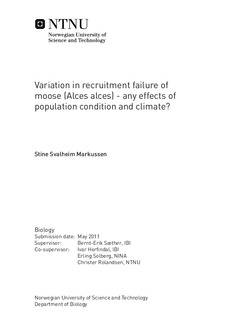Variation in recruitment failure of moose (Alces alces) - any effects of population condition and climate?
Master thesis
Permanent lenke
http://hdl.handle.net/11250/244829Utgivelsesdato
2011Metadata
Vis full innførselSamlinger
- Institutt for biologi [2614]
Sammendrag
Summary1. Recruitment failure may represent an important demographic response to changes in the environment or in population size. In this study, I examined whether there was a positive relationship between recruitment rates and ovulation rates in year t-1 in eight Norwegian moose populations. Further, I examined how body condition and climate affected the spatiotemporal variation in recruitment rates and ovulation rates. 2. Both recruitment rates and ovulation rates exhibited spatial and temporal variation. The ovulation and twin ovulation rate in yearlings showed more temporal variation than in prime-aged adults. Furthermore, twinning rates varied more than ovulation and calving rates.3. The number of calves per female recruited to the population was positively related to number of eggs per female the previous year. More calves per female were recorded in years with a high June temperature, smaller snow depths and larger yearling body mass, indicating that more egg cells are realised into a calf in years with good living conditions.,4. Additionally, more calves per female were found in regions with higher number of eggs per female, cool June temperatures and low snow depths. The level of recruitment failure varied among regions, and was highest in Vestfold which is associated with low ovulation rates and body masses. This shows that prenatal or neonatal losses of offspring are likely to be an important demographic response in moose to changes in population size or in the environment.
